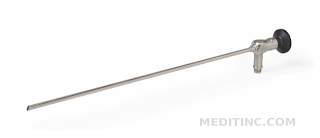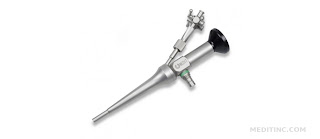Endoscopy
is performed with either a rigid or flexible endoscope. Flexible
endoscopes consist of a long, flexible tube with a bending tip at the
end that enters the body, an eyepiece, and a control section. The tip of
the endoscope is manipulated using a control knob in the hand piece. In
addition to the fiber bundles which provide the light source, two
channels are present within the endoscope. One channel permits various
endoscopic tools to be passed and fluids to be suctioned or samples
taken. The other allows air or water to be passed into the studied place
or wash away mucus from the viewing port. Special video cameras can be
attached to the endoscopes which allow viewing on a television screen.
Rigid endoscope cannot be used in some areas, such as the stomach
because it does not have the bending tip, so it cannot be flexed to
allow examination of all parts of the stomach.
Endoscopy can be used in different areas. Flexible endoscopy - Bronchoscopy: an exam of the lower airways; Colonoscopy: an exam of the transverse colon, ascending colon, cecum, large bowel, and rectum; Endoscopy: an exam of the stomach, and upper intestines. Rigid endoscopy - Arthroscopy: an exam of soft tissue structures and joint cartilage.
Decreased damage to the joint and shortened recovery times are two
advantages of arthroscopy over arthrotomy (surgical exam of the joint); Cystoscopy: an examination of the vagina, urethral opening, urethra, bladder, and ureteral openings; Laparoscopy: an exam of the abdominal cavity performed through a small incision in the wall of the abdomen or through the navel; Proctoscopy: an exam of the large bowel and rectum; Rhinoscopy: an exam of the nasal cavity and nasopharynx (junction between the nasal area and the back of the throat).



